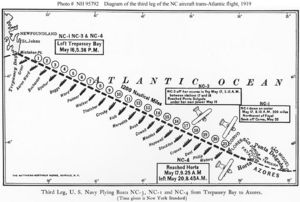PlaneSpottingWorld welcomes all new members! Please gives your ideas at the Terminal.
Curtiss NC
The Curtiss NC (Navy Curtiss, nicknamed "Nancy boat" or "Nancy") was a flying boat used by the United States Navy from 1918 through the early 1920s. Ten of these aircraft were built, the most famous of which is the NC-4, the first airplane to make a transatlantic flight.

Contents
Development
Manufacture of the "NCs" began in 1918 during World War I. The U.S. Navy wished for an aircraft capable of long ocean flights, both for Anti-submarine warfare patrol, and if possible with capability to fly across the Atlantic Ocean under their own power to avoid having to be shipped through ocean waters menaced by German submarines. This was very ambitious given the state of aviation at the time. The Navy and Curtiss came up with one of the largest biplane designs yet produced, equipped with sleeping quarters and a wireless transmitter/receiver. It was originally powered by three V12 Liberty engines, of 400 hp (298 kW) each; during the testing phase a fourth engine was added, arranged as three pullers and one pusher. Maximum speed was 90 mph (144 km/h) the estimated maximum range was 1,500 miles (2,400 km).
In service
On October 4 1918, the first of these planes, the NC-1, made its first test flight with the early 3 engine configuration. On November 25 it flew again, with a world record 51 people on board.[citation needed] In the meantime, Armistice Day had come, signaling the end of the war in Europe, before testing of the first NC and construction of the other 3 of the Navy's initial order had been completed.
The NC-2 suffered damage during the testing phase and was cannibalized for spare parts.
The other three NCs, NC-1, NC-3, and NC-4, set out on what was intended as the first demonstration of transatlantic flight, via Newfoundland and the Azores, on 8 May 1919, with Marc Mitscher in the NC-1 in command. The group encountered severe weather off the Azores, and only the NC-4 made it through (the crews of the other craft were rescued at sea). See the NC-4 article for more details of that expedition.
The Navy had two more sets of NCs constructed, numbered NC-5 through NC-8, and NC-9 and NC-10, through 1921.
Specifications (NC-4)
General characteristics
- Crew: six
- Length: 68 ft 3 in (20.8 m)
- Wingspan: 126 ft (38.40 m)
- Height: 24 ft 4 in (7.40 m)
- Wing area: 2,380 ft² (221 m²)
- Empty: 16,000 lb (7,260 kg)
- Loaded: 27,386 lb (12,422 kg)
- Maximum takeoff: lb ( kg)
- Powerplant: 4x Liberty engines, 400 hp (298 kW) each
Performance
- Maximum speed: 95 mph (152 km/h)
- Range: 1,470 miles (2,352 km)
- Service ceiling: ft ( m)
- Rate of climb: ft/min ( m/min)
- Wing loading: 11.5 lb/ft² (56.3 kg/m²)
- Power/Mass: 0.06 hp/lb (0.01 kW/kg)
Operators
Related content
Lists relating to aviation | |
|---|---|
| General | Timeline of aviation · Aircraft · Aircraft manufacturers · Aircraft engines · Aircraft engine manufacturers · Airports · Airlines |
| Military | Air forces · Aircraft weapons · Missiles · Unmanned aerial vehicles (UAVs) · Experimental aircraft |
| Notable incidents and accidents | Military aviation · Airliners · General aviation · Famous aviation-related deaths |
| Records | Flight airspeed record · Flight distance record · Flight altitude record · Flight endurance record · Most produced aircraft |



